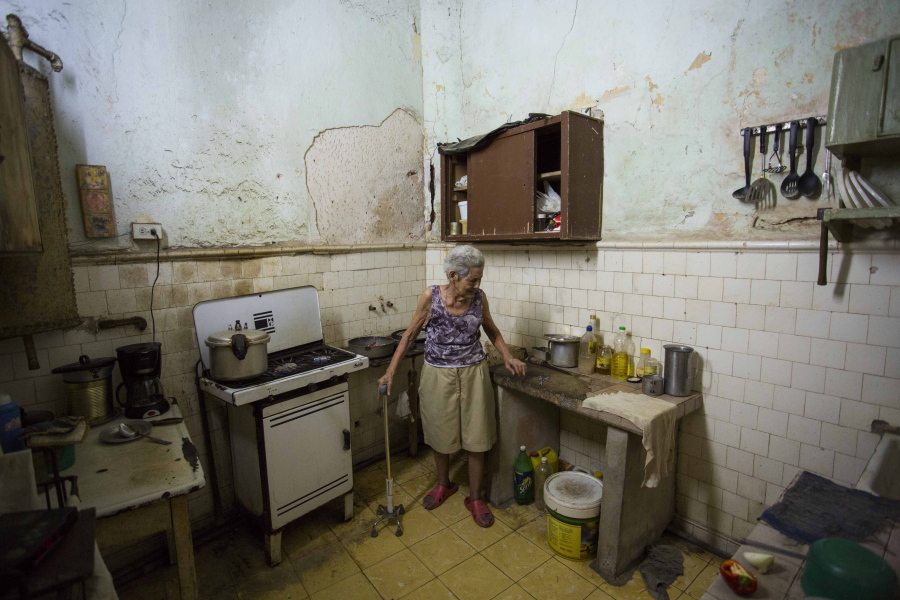HAVANA — Halfway down Calle Habana, a crumbling two-story colonial building is being painstakingly restored by a Cuban-American businessman who fled as a child after the 1959 revolution. On the corner, brightly colored paintings hang in a home now converted into a chic art gallery.
Not far away, dozens of people live in a crumbling government tenement with no running water and wooden stilts holding up what remains of the second floor.
Looking at the changes on the cobblestone street in Old Havana, Magaly Gonzalez Martinez is pleased to see much of the once-decaying neighborhood get a new coat of paint. But she also worries how the transformation will impact those living in deteriorating buildings like her own as a wave of gentrification transforms swaths of Havana, bringing the inequities of modern real estate to one of the world’s last communist countries.
“I thought everything should be equal, no?” the 66-year-old retired construction worker said.
With tourism up nearly 20 percent since Presidents Barack Obama and Raul Castro ended a half-century of Cold War in December 2014, Cubans with wealthy friends or family abroad are funneling millions of dollars into a real estate market that’s suddenly white-hot. They’re snapping up properties in historic Old Havana and elegant residential neighborhoods and transforming them into immaculate restored rental properties and hip bars and restaurants.
In some tourist-flooded neighborhoods the redistribution of wealth that transformed Cuba after its revolution appears to be rewinding before people’s eyes. Wealthy Cubans who left to live abroad decades ago are buying buildings once confiscated from families like theirs. Residents who had been living hand-to-mouth are selling deteriorating properties and taking their new fortunes and moving to less sought-after areas, or leaving the country entirely.
“When I arrived, it was totally different,” said Reinaldo Bordon, 44, who purchased the Calle Habana property where he runs Habana 61, one of the city’s top restaurants, with two friends three years ago. “If things continue at this pace, I think in another 10 years it will change a lot.”
Before Fidel Castro’s revolution, well-heeled Cubans lived in exclusive Havana neighborhoods like Miramar, while the poor lived in shantytowns. Providing equal housing was one of the revolution’s first goals. Almost immediately, evictions were prohibited and rental payments slashed up to 50 percent. Droves of middle- and upper-class Cubans fled, leaving behind mansions and suburban homes that the state handed out to the poor. The result was a leveling of Havana’s housing stock, with former maids and tenants becoming the proprietors of homes now managed by the state.
In 2011, Cuba announced it would allow people to sell their properties for the first time since the early years of the revolution. The new law set into motion what had not formally existed in decades: a Cuban real estate industry. Cubans living in peeling architectural gems began placing cardboard signs out front, inscribed with the words, “For Sale.”
Fueled by the post-detente boom in visitors, the resulting property turnover is moving at high speed in areas like Old Havana, where aging colonial buildings are being repaired on nearly every block.
On Calle Habana in the small, scenic Old Havana neighborhood known as Angel Hill, newly painted and restored homes dating back to the early 1900s are quickly beginning to outnumber deteriorating buildings on the verge of collapse. Those who live in the few still decaying homes are listing their properties on real estate websites, waiting for the right buyer to come along and in one financial transaction lift their families out of decades of poverty.
Though foreigners still cannot purchase property in Cuba, Joel Estevez, the director of Havana-Houses Real Estate, said about 60 percent of home purchases in Cuba are financed at least in part by someone abroad.
After Obama and Castro announced plans to restore U.S.-Cuba relations, the number of Cuban-Americans repatriating in order to purchase property while maintaining their U.S. citizenship has soared and could double in the years ahead, Estevez said. In other cases, a foreigner who is married to a Cuban might purchase a property and put it under a spouse’s name. The riskiest transactions involve foreigners who have no family members on the island but purchase a home and put it under the name of a friend.
After scoping out Havana properties over several visits, 70-year-old retired businessman Jose Angel Valls Cabarrocas settled on a stately but neglected home on Calle Habana, next to the tenement building. Cabarrocas and his family fled their Miramar home for Macon, Georgia, when he was 13.
“We belong here just as much as anybody else,” he said.
The nascent market favors people like Cabarrocas, who despite the difficulties of transferring cash to Cuba, nonetheless have the capital on hand to make purchases. With no financing available, the vast majority of Cubans are left out of the market. The average home price in Havana is about $25,000, according to real estate statistics collected by IslaData. The average Cuban state worker earns $20 a month.
“The median home price is very disconnected from what the average Cuban earns,” said Ricardo Torres Perez, an economist at the University of Havana.
Some Cuba observers wonder if the real estate market will slowly shift Havana back toward the inequality that characterized it nearly six decades ago.
Jesus Hermida Franco, 41, an artist who is using the bottom floor of his family’s home on Calle Habana as a studio, said he doesn’t see it that way. In his mind, there always remained some degree of inequality and class division in Cuba. If anything, the market is giving people a shot who didn’t have one before.
“Thanks to these changes people have been able to realize their dreams,” he said, then added: “Some people.”
——–
Associated Press writer Michael Weissenstein contributed to this report.



